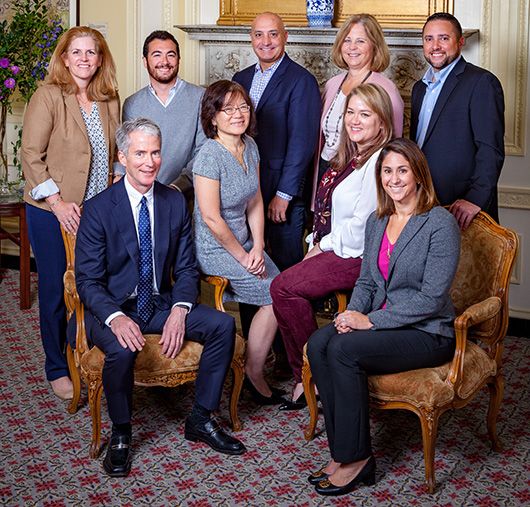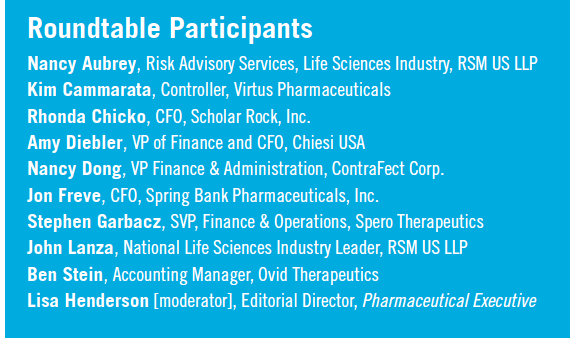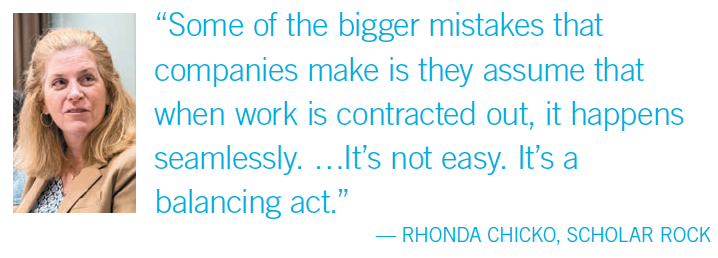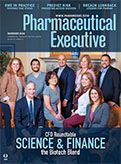Science & Finance: The Biotech Blend
Financial leaders from clinical-stage biopharma gather to discuss the critical role of finance and accounting (F&A) in supporting and sustaining the science at the forefront of engagement with investors.
Biotech Business Ramp-Up: Adding Credibility to Narrative
Pharm Exec convenes a panel of financial leaders from clinical-stage biopharma to discuss the critical role of finance and accounting (F&A) in supporting and sustaining the promising science at the forefront of investor engagement
At the recent CBI Finance and Accounting for Bioscience Companies conference, professionals from small- to mid-sized biopharma gathered to learn from each other and discuss their unique challenges. Typically, smaller-staffed organizations, with their smaller-staffed departments, require their executives to be accountable for much more than those serving at a larger pharma manufacturer. They wear multiple hats, get involved with diverse projects, and make decisions impacting the future financial vitality of their respective organizations-and their scientific prospects as well. RSM, hosting a breakfast roundtable for these professionals, graciously allowed Pharm Exec to moderate “The Role of the Finance Leader in Scaling the Biotech Business.” What follows below are edited excerpts from a very insightful and robust discussion.
Photo/Porter Gifford. (Left to right, standing) Rhonda Chicko, of Scholar Rock; Ben Stein, of Ovid Therapeutics; John Lanza, of RSM; Nancy Aubrey, of RSM; Jon Freve, of Spring Bank Pharmaceuticals; (sitting) Stephen Garbacz, of Spero Therapeutics; Nancy Dong, of ContraFect Corp.; Kim Cammarata, of Virtus Pharmaceuticals; and Amy Diebler, of Chiesi USA.

PE: How do you stay on top of both the financial insights as well as the science information needed to do your job effectively?
Stephen GARBACZ, Spero Therapeutics: In terms of obtaining the latest financial information, I use online systems like NetSuite and Coupa, where I can access up-to-the-minute information to stay informed on where we are. For the science, I talk to the professionals in our organization, many of whom are leaders in their field. I also read select publications like Pharmaceutical Executive and a number of blogs, such as the Luke Timmerman Report, Life Sci VC, and Endpoints.

NANCY DONG, ContraFect Corp.: In our company, we’re relatively small still, about 30 people in the office. And because I have responsibility for HR, I have become more aware of the staff’s needs. Over the last two years, we have had a Lunch and Learn and invited our staff scientists to talk about what they do. In the past, I would try to pick up the science in the hallway or get myself invited to clinical team meetings or the project team meetings.
But the Lunch and Learns have been very successful for everyone.
Be sure to attend the 15th Annual CBI’s Life Sciences Accounting and Reporting Congress March 20-22. The Largest and Highly-Acclaimed Life Sciences Event for CFOs, Controllers and Finance Executives.
RHONDA CHICKO, Scholar Rock: I consider what the company will need to finance and fund the operations for the long term. We will regularly consider what resources are required to continue progressing the science. I try to look well beyond the current plan. I am always looking to understand our budgeting and cash position, and making sure that the decisions we’re making today will enable us to be viable in 18 months to two years out.
Even for the early stage companies, and perhaps it’s actually more important, to make sure that you bring on the FP&A (financial planning and analysis) skillsets to instill financial responsibility throughout the organization. Because from the science standpoint, you need to know, are we really going to be able to do a trial with this number of patients? What does a CRO cost? What does a CMO cost? Try to make sure that you start that process very, very early on or else companies might find themselves in some pretty tight situations.
JON FREVE, Spring Bank Pharmaceuticals: On top of what everybody else already brought up, our core management team meets at least twice a month to continually assess how the overall competitive landscape is changing. Our lead target is designed for the treatment of chronic HBV (hepatitis B virus), which is a highly competitive area following the recent success with the treatment of HCV. That said, we are strong believers that the HBV treatment paradigm will be a multi-mechanism approach that will require collaboration working with other companies and their mechanisms.

Not only do I need to currently monitor our internal progress and clinical developments, but I’m regularly looking at the emerging issues and/or developments in the overall HBV space.
With regards to our lesser-known programs, we’re continuously monitoring organizations that develop targets or focus on indications where we are active. For example, our secondary program, a STING agonist for the potential treatment of certain cancers, is also in a very competitive space. There are many companies that have started to enter the clinic, but we have not yet done so. This timing allows us to look for their data to guide us a little bit.
It’s not only staying on top of our internal developments with our own science and our own clinical trials, but really continuing to monitor the overall landscape. That’s important as we make decisions as to where we’re going to look to spend our funds over the course of the next 18 to 24 months.
PE: How important is your company’s narrative-your story when you speak to investors, stakeholders, or potential business partners?
FREVE: It’s critical. We have a complex story, so it takes a little longer to tell. Sometimes I’d prefer to have a 60-second elevator pitch, but we are a dynamic, young company with a platform of targets, and we have to explain it well-and that’s not as straightforward as you might think. It’s not, “we’ve got one pill that’s going to cure it all.” It’s, “we’ve got to work with multiple mechanisms and collaborate with a few other companies and hopefully we’ll be the backbone therapy in those mixes that eventually move forward and provide a functional cure.” When we’re out on the road-whether it’s non-deal road shows or actively raising funds-that’s how we attract new investors. And if we can’t communicate that story effectively, we’re not going to be able to bring in the additional funds necessary.
Similarly, with existing investors, we have to continue to keep them engaged and show them where their investment is going, which allows us to continue to progress the science. And if we’re not telling that story in an effective way, we’re going to lose certain investors if they’re not happy with either the speed of development or the direction that we’re taking the development plan. Also, if you have delays, be able to explain those delays. Talk about challenges and how you’re overcoming them and moving the programs forward.
The story is critical. I’m on the road quite often and that story evolves regularly. That’s a big part of being able to continue to stay ahead of things; adapt your story to where not only the competitive landscape is going but where your company is going. I think that’s important for all of us as financial executives-being able to tell that story effectively.
GARBACZ: The company’s story is very important. The investors are interested in the science and the portfolio’s prospects. They are also interested in the company’s cash position and runway, and if the company’s financing strategy can credibly support its narrative.
AMY DIEBLER, Chiesi USA: The Chiesi story is a very important component of these conversations, because most are focused on collaboration and partnership, where trust is at the center.
Chiesi is a family-owned company, and after more than 80 years, the second and third generations of the family still work here. So, when we’re talking about acquiring assets, or collaborating with a biotech company on its R&D, or becoming its commercial partner, our history of financial stability and commitment to the science are front and center.
The fact that our owners want to see medical innovation advanced to the next level is meaningful. In fact, more often than not, our story is the reason we are chosen as partner.
DONG: We have a deck our team uses, but every so often we present it to the entire company so that our team inside knows what we’re saying out there in the market. Our teams on the inside really enjoy them, especially our team in the lab. They used to say, “Oh, the corporate world does a lot of things that we don’t know about. We don’t even know if they know the science.” But now they know and it’s a lot of fun because we have received very particular questions about the science from our internal staff.
BEN STEIN, Ovid Therapeutics: Because we’re in the rare orphan disease area, engagement with the patient community is an area that we really strive to be a part of. That provides something to the employees as well.
We try to communicate with the staff as often as we can about what’s going on with the clinical trials and get them involved with the patient community as well. Whether that’s through Facebook, LinkedIn, online, other social media-getting them involved is something that strengthens the engagement and the story.
GARBACZ: I think one of the great advantages of a small company is that everybody is a bit closer to the science. And a lot of the scientists and research people love explaining what they’re doing and what’s going on, almost like a professor. Actually, some of them are professors.
JOHN LANZA, RSM: All of your companies are different. I’ve always wondered, if the founder is the scientist, do they talk differently versus a non-founder scientist? About numbers, cash, runway and spend, and all that?
DIEBLER: Our founder, Giacomo Chiesi, was a scientist, and the second generation of the family has scientists among them as well. But what’s interesting about Chiesi is that the family has always been visionary about how to achieve their ultimate goal. If we’re going to develop therapeutic solutions that

improve the quality of life and health of people, we’ve got to be financially and operationally healthy as well.
As the company grew, Chiesi hired non-family members in senior leadership to provide additional business acumen and balance. They knew they needed to have a CEO and CFO who would pursue the scientific vision from a business point of view.
GARBACZ: What is interesting is that a lot of the security analysts now have PhDs and know the science inside out, so you need someone that is respected and can credibly talk with this community.
CHICKO: We also have a couple different approaches and a couple different levels of our story. One of the things we do is assess to make sure we know our audience. Who are we talking to? Sometimes even before we start, we have a conversation about their backgrounds and ask them about their level of scientific knowledge.
Someone mentioned during the conference that you have to be careful whenever you speak. If you start throwing out medical buzzwords, be careful in case someone calls you on it. Our CEO is excellent at making sure he understands the scientific background for whomever he is speaking with and making sure the person is responding-and, if not, then take a different approach. Having a couple of different pitches works well.
PE: What leadership skills do you draw on most in your role?
FREVE: For me, it’s adaptability. It’s critical. We’re a small company, 25+ employees. I wear many different hats, whether it’s finance, HR, investor relations, IT, facilities. Just recently we built out a new lab space and a new office space where we were moving two locations, consolidating into one; that entailed building out a 10,000 square foot lab facility.
Although the scientists are the most knowledgeable about lab requirements and where they want to build certain aspects of the chemistry lab versus the biology lab versus the NMR (nuclear magnetic resonance) room, etc., it was ultimately me that ended up participating in all the meetings, helping transition everything over to our contractor in working through the build-out.
I learned more about the lab than I ever thought I would, which was great, but I think it’s having the ability to really just put on that different hat and focus on the task at hand and do what needs to get done. That’s critical, especially in a small company world. It’s being able to adapt and work with whatever aspect is coming my way that particular day and take that challenge head on.
GARBACZ: I’ve had the same experience early on in the company-needing somebody that can do just about everything and is comfortable with the uncertainty that comes with biotech. And the organization evolves over time. First, the company is a relatively simple early stage research organization. So you initially focus on accounts payable and managing expenses. Next, you may have collaborations or government grants, and then financial reporting becomes more complex because you have to work with your collaboration partner and provide them with timely planning and reporting.

If successful, the company will then progress into clinical trials and the early stage research may become relatively less important. At this point, the company will need to begin hiring clinical and regulatory people that have a different skillset. That changes the culture as well because the company becomes a little more organized and regulatory oriented, and a little bit less academic. Once the company approaches commercialization, you will then need to bring in the salesforce, which is an entirely different group with a new personality.
I think successful senior executives must be able to provide effective leadership across that continuum, adapt to each new phase of the business, and recruit people that embody the company’s core culture.
PE: How much do you outsource to third-party providers and how does that experience go?
FREVE: CROs are our largest source of cost and it’s very difficult to manage the costs. As a smaller player, we don’t have the same leverage as a large pharma. We bid all our CRO work through a competitive proposal process. It’s a challenge to keep them on budget as they’re rarely incentivized for efficiency. It’s definitely an area that will be difficult to improve on as a small player in the space.

CHICKO: It is hard. And we are challenged, as you said, because we’re small companies. We don’t have all the resources and the infrastructure to be able to do a lot of this work, so we need to contract out. I think some of the bigger mistakes that companies make is they assume that when it’s contracted out, it happens seamlessly. It’s my experience that when companies apply an internal resource to manage these relations, you have better luck. But for many small start-ups, it’s almost a luxury to bring in someone to provide oversight to these different contracts and contractors. It’s not easy. It’s a balancing act.
GARBACZ: We’ve seen that as well. When a company is small and developing, there are often a number of jobs that are not yet full-time positions. Outsourcing to a third-party provider, or contractors, can be used to fill the current gaps and provide scale as the company grows. A contractor who works a couple days a week on quality or even in the finance department, can make sense for an early stage company. And for Spero, as we go back to the discussion about how the company evolves over time, our decision to have outsourced a lot of the early stage research, as opposed to bringing it in-house, was beneficial, because we subsequently shifted our focus to clinical development and reduced our need for early stage research.
Rhonda is right, you really need to closely manage third-party providers and stay on top of them.
PE: You all have different pathways to your current role in a smaller biopharma. How do you feel about working in this industry?
GARBACZ: I really enjoy my job and really love working in biotech. Cambridge is like the center of the universe in that respect-there’s so many opportunities and interesting things to do, and great people as well. Everyone that you work with and meet with are intelligent, nice people.
FREVE: Biotech, from my perspective, is by far the most collaborative industry out there. We’re all rooting for each other, because it’s for the right reason.
Even though we may be competitive in a certain space, we want to see others succeed, because the outcome obviously benefits a broader group. From that perspective, it’s exciting to be a part of the entire biotech space.
GARBACZ: You’re doing something that benefits people.
DIEBLER: Our work is important and rewarding. We’re changing lives.
Lisa Henderson is Pharm Exec’s Editor-in-Chief. She can be reached at lisa.henderson@ubm.com
The 15th Annual CBI’s Life Sciences Accounting and Reporting Congress takes place March 20-22. Don't Miss the Largest and Highly-Acclaimed Life Sciences Event for CFOs, Controllers and Finance Executives.

An Evolving ‘Opinion’ Landscape: New Paths—and Synergies—for Pharma KOLs & DOLs
October 13th 2023Industry experts discuss the relationship between digital and traditional (key) opinion leaders and how companies are adjusting their strategies to harness the unique brand engagement benefits each role can provide in driving better patient outcomes.